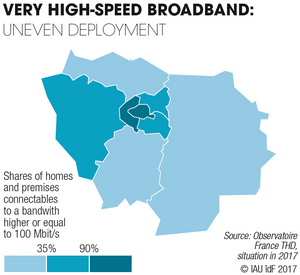Paris Region: the challenges of “smart” planning
With 500,000 jobs in the digital sector, the deployment of fiber optic networks for all, the existence of numerous early adopters and the multiplication of data centers, etc., the Paris Region is extensively involved in a digital transformation process which has mobilized its greatest strengths. However, faced with challenges that are continually changing, it is essential to involve all the region's inhabitants and territories in the dynamics of this process.
Although digital transformation processes often seem to find it difficult to come to terms with existing cities, the Paris Region’s first steps towards becoming a Smart Region were paradoxically driven by its history and geography.
What are this Region's strengths? Its density and diversity, of course, but also its Haussmann period urban fabric in the heart of the agglomeration whose investment properties have proved to be highly adaptable to new technologies (the central business district is still home to the most attractive buildings).
Another heritage from the Haussmann period is the large sewerage network (visitable by technicians) thanks to which the fiber optic network has been rapidly deployed. Another strength is the region's industrial past, which provided the first data centers with locations in the heart of the agglomeration very well-equipped with electric power.
Density, diversity, profitability
Although the Paris Region's density and diversity are its unquestionable strengths, they are unequally spread across the territory. With around 1,000 inhabitants per square kilometer, the Paris Region is 10 times denser than the rest of mainland France. This density operates in favor of the profitability of networks, because, for the same linear cost, a similar segment serves a larger number of potential users. This diversity, however, is very unequal, being much greater in Paris (which used to be the densest city in Europe because it had been walled) than in the rest of the Paris Region which is home to only one tenth of the population, which occupies three quarters of the surface area of the Paris Region. Another advantage is functional diversity. Even though relatively recent monofunctional zones (featuring housing estates, business parks, etc.) have stamped their mark on some of the region's landscapes, the housing, business, education and leisure functions remain very intermixed within the Paris Region. Thus, 70% of jobs are spread over the mixed urban fabric rather than concentrated in dedicated areas. Functional mixing lowers the profitability threshold of infrastructures by allowing operators to market a professional and residential offering based on the same infrastructures. Moreover, when combined with density, functional mixing increases the intensity of the economic and social interactions that are indispensable to innovation in the fields of services and digital uses. However, as for density, this functional mixing is much greater in Paris than in the rest of the agglomeration and region.
Fiber optics for all by 2020?
Like all the regions of France, the Paris Region has undertaken to generalize access to very high-speed networks with complementary public and private sector investments. Due to its relatively high density, the “private initiative” zone covers the entire urban agglomeration and concerns nearly 90% of Paris Region inhabitants. This special situation has enabled public and private stakeholders to agree on the objective of generalizing access to fiber optic networks with a view to becoming the leading fiber optic region in Europe by 2020. Although the deployment of fiber optics is under way, it is unlikely to be completed by 2020 because some public initiative networks have suffered delays. In addition, the agreements between the two major private operators seem to have been called into question. This delay is a cause for concern as major inequalities remain. Thus, in Paris, nearly 100% of homes and business premises potentially have access to a very high-speed internet connection (bandwidths higher than or equal to 100 Mbits/s). In Hauts-de-Seine county (west of Paris), this percentage remains high at 92% but falls to only 62% in Seine-Saint-Denis county (north-east of Paris). In the outer suburbs, the rate is 54% in Yvelines county, whereas in Val-d'Oise, Essonne and Seine-et-Marne counties, it varies from 33 to 35%.
Improving tomorrow's mobile network
As regards mobile networks, the quality of coverage is good in the Paris Region. According to the operators, there is general coverage on 1G, 2G and 3G networks. Around 20 white areas remain, which are located in the rural areas of the outer suburbs and are generally quite small. As regards the 4G network, the coverage rates vary according to the operators, ranging from total theoretical coverage to offerings aimed only at urbanized areas. However, these positive results must be qualified if we take into account the capacity of existing networks to meet future changes in demand. There will be a sharp growth in needs for mobile communications. Current capacity will not be able to meet this growth. The densifying of networks, if only to relay mobile Wi-Fi in trains, will require considerable investments by operators. Finally, the forthcoming introduction of the fifth generation (5G) mobile network is a crucial issue. This technology has been designed to meet the expected explosive growth in connection volumes, notably due to the multiplication of connected objects or the introduction of self-driving vehicles. Rapid generalization of the 5G network on the scale of the Paris Region will therefore be a major challenge.
Digitalization will require electricity
Telecommunication networks have turned data centers into the “invisible” substructure of the information society, the digital economy and the Smart City. Contrary to certain preconceived ideas, data centers cannot free themselves from the constraint of being relatively close to their users for both technical and psychological reasons. In the Paris Region, the data centers are mainly located in three areas: central Paris, the La Défense business district, and especially Plaine Commune, which probably has the highest concentration of data centers in continental Europe. Given the development of the digital economy, their number will continue to grow. Although they are getting more energy-efficient, the rise in consumption due to new arrivals should represent a consumption level equivalent to a city of one million inhabitants by 2030. Faced with such an increase in demand, the risks of undercapacity in the near future are real, because the adaptation of electricity networks is slow for structural reasons. It is therefore urgent for operators and planners to do some collaborative thinking about how to increase the capacity for accommodating newcomers and new activities.
Dynamics that need to be shared
The core area of the Paris Region creates the new services that it uses, but there is still a need to make them accessible to everybody. The Paris region, within a geographical area that represents 2% of France, accounts for half of all the digital jobs in the country and provides an ecosystem that is very conducive to innovation in the field of digital services, featuring a diverse network of large corporations, start-ups, universities and laboratories which rely on a wealth of human, financial and institutional resources (such as the Cap Digital and Systematic competitiveness clusters). This network is also embedded in physical locations conducive to fruitful interactions mainly in the heart of the agglomeration (70% of digital jobs are concentrated in Paris and the Hauts-de-Seine), but also in Cité Descartes in Champs-sur-Marne (Seine-et-Marne) or near the campus of the prestigious École polytechnique in Palaiseau (Essonne). This ecosystem also benefits from the presence in the Paris Region, for a long time the cultural and economic capital region, of a large population of people hungry for digital technology and with an international outlook. These people tend to be young, cultured and often affluent. They form a diverse group of entrepreneurs, high-potential executives, start-up founders and the invisible multitude of early adopters, the pioneers who set the trends. This group functions as a breeding ground for imagining, creating, testing, validating and disseminating new applications almost in real time. This population provides an opportunity for the Paris Region to help define and influence the digital world of the future. By porosity, it shapes the digital city by enabling the majority of people to take ownership of its uses. Today, this population is, to a large extent, concentrated in the heart of the agglomeration and could in future be more selective as regards its spatial choices (home, work, leisure, etc.). This outcome would be detrimental to areas less well endowed with digital infrastructures and services. As a result, without any upgrading to correct disparities, there is a greater risk that the Paris Region will once again have two very different faces.
Nicolas Laruelle, urbanist and Daniel Thépin, economist, IAU îdF
This page is linked to the following category :
Economy

